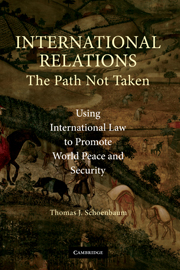Book contents
- Frontmatter
- Contents
- Preface and Overview
- 1 Introduction: Two Very Different Wars in Iraq
- 2 The Twenty-First Century – The End of History or a New Beginning?
- 3 International Power Politics
- 4 A New Global Order Based on International Law and Multilateralism
- 5 Peace and Security: Reinventing the United Nations
- 6 International Political Economy
- 7 International Environmental Protection
- 8 International Human Rights
- 9 International Crimes
- 10 Conclusions
- Index
- References
7 - International Environmental Protection
Published online by Cambridge University Press: 23 July 2009
- Frontmatter
- Contents
- Preface and Overview
- 1 Introduction: Two Very Different Wars in Iraq
- 2 The Twenty-First Century – The End of History or a New Beginning?
- 3 International Power Politics
- 4 A New Global Order Based on International Law and Multilateralism
- 5 Peace and Security: Reinventing the United Nations
- 6 International Political Economy
- 7 International Environmental Protection
- 8 International Human Rights
- 9 International Crimes
- 10 Conclusions
- Index
- References
Summary
A PROMISING START
Beginning in 1925, a smelter that was processing copper ore in the town of Trail, British Columbia, spewed out tons of sulphur dioxide fumes, causing respiratory diseases and inflicting damage to homes and businesses across the border in the state of Washington. The U.S. government protested to Canada, but to no avail. The company was privately owned and was doing nothing illegal. Lightly populated British Columbia did not require pollution controls. The smelter was beyond the reach of U.S. law, so nothing could be done. After years of protests and worsening misery, the Canadian government agreed to submit the controversy to a Special Arbitral Tribunal. In 1941, a decision was handed down, the first case involving adjudication of an international pollution dispute. The tribunal found that, under principles of international law, “no State has the right to use or to permit the use of its territory in such a manner as to cause injury … in or to the territory of another when the case is of serious consequence and the injury is established by clear and convincing evidence.” The tribunal awarded compensation to the United States and imposed measures of control upon the smelter's operations, including the maintenance of meteorological records and the specification of maximum hourly emissions of sulphur dioxide under various conditions.
The Trail Smelter case, as this is known, is still a landmark decision of international environmental law.
- Type
- Chapter
- Information
- International RelationsThe Path Not Taken, pp. 196 - 249Publisher: Cambridge University PressPrint publication year: 2006



